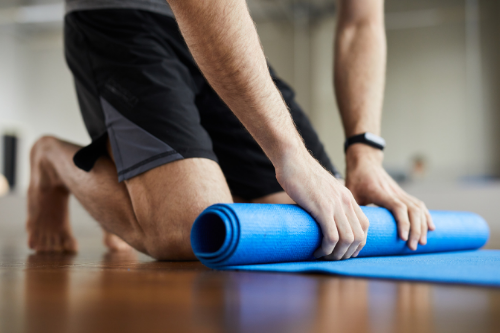Stretching and foam rolling. Two words that you may have come across when reading fitness articles, listening to conversations at the gym or watching fitness YouTubers. You know that they may be good for your body, but what exactly is it and what are their benefits?
Stretching is important as it improves your flexibility and balance which then enhances your physical performance. It warms up your muscles for your exercise, making your exercise feel a lot smoother and reduces risk of injury. To put in technical terms, it is the deliberate action of lengthening the muscles to increase your muscle flexibility and range of motion in the joints. Stretching is not only recommended in your workout, but also your daily life.
Foam rolling is a nice addition to stretching as it soothes the soreness of your muscles from your workout. It is a self-myofascial release (SMR) technique–an exercise that helps smooth out the connective tissues that attaches and stabilises the body, otherwise known as fascia. It relieves muscle tightness, soreness, and inflammation, and increase your joint range of motion. Like stretching, it can be used as a warm-up or cool down.
Types of Stretching and their Benefits
You now know that stretching promotes flexibility and reduces risk of injury. However, you may not know there are two types of stretches–dynamic and static.
Dynamic stretches are continuous movement where the muscle goes through the full range of motion. It is not held for any length of time. Some examples of dynamic stretches are hip circles, lunge with a twist, arm circles, and spinal rotations. These types of stretches are recommended for warmups as it gets your muscles ready for more vigorous movements and reduce risk of injury. It promotes flexibility by strengthening the muscles around your joints and improves performance in speed, agility and acceleration. As dynamic stretches mimic the movements of your workout, it further prepares you for the patterns and actions and improves your body awareness

Static stretches–the type we most commonly do–are stretches where you extend a muscle to the end of its motion and hold. These stretches are recommended to be held for 30-45 seconds. Rather than doing this before your workout, it is recommended to be done 5-10 minutes after your workout during your cool down. This is so that your body will return to its normal state. Static stretches not only relaxes your body, but also elongates the muscles and promotes faster recovery. This particular stretch also improves flexibility and postural awareness.
Benefits of Foam Rolling
When your muscles are sore, the foam roller is your best friend. Foam rolling helps to ease sore muscles and reduces inflammation, helping you get through those rest days for the next time you hit the gym!
Although the primary benefit of foam is to decrease delayed-onset muscle soreness, it has a wider range of benefits. It alleviates the tension in the muscle tissue by targeting muscles and fascia–the tissue that connects your muscles and helps hold them and the rest of your body in place. It releases the pressure and softens the tissue from restrictions like scar tissues and trigger points.
It does this through increasing bloody flow to the area you are rolling. As you roll your muscles, you are pushing the blood away then it rushes back in.

The release of tension and increase of blood flow is important for your workout’s pre-care and after care. Before your exercise, it warms up your muscles because of the increased blood flow. Studies have found that foam rolling for five to ten seconds increases your range of motion. Post-workout foam rolling that it reduces delayed-onset muscle soreness. Debra Stroiney, professor of sport and exercise science at Gannon University, explains, “The increased blood flow helps bring nutrients to your muscle tissue, so you recover faster. The blood brings anti-inflammatory properties to the area, which may help you not be as sore later one.”
Is Stretching or Foam Rolling Better?
Both stretching and foam rolling have their place and provide great benefits to your body.
Rather than choosing one, it is recommended that both foam rolling and stretching should be part of your routine. It can be highly beneficial to use both for their different purposes. Though incorporating foam rolling and stretching to your exercise may seem like a lot, doing both from time-to-time can give your body and workout a boost!
It is also beneficial to foam roll and stretch during your rest days. Stroiney says, “Foam rolling on a daily basis isn’t going to hurt you. If anything, the people I know have felt better because of it.” The increase of blood flow assists muscle recovery, and it definitely alleviates your soreness. Dynamic stretching is great to do when you want to re-energise or in the morning to prep your body for the day.

Though stretching and foam rolling help your body with different issues, they compliment each other to boost your physical performance and workout. Implementing these into your routine will make you feel better as you exercise and relaxed when you are resting. It is crucial to know how to take care of your body while you are exercising to effectively gain the best results.
Stretching and foam rolling can also help you feel refreshed and energised during your rest days. Your muscle soreness will be alleviated, giving you an energy boost for your day. This momentum will create positive impacts in your life by strengthening your motivation and mood.
By incorporating foam rolling and stretching into your fitness routine, you will feel a difference in your muscles and movement, inside and outside the gym!
To learn more about achieving core activation and greater flexibility see: Wellness Yoga








